 |
Fort Jesus
Mombasa, Kenya
|
|
 |
Constructed: 1593 - 1596
Used by: Portugal,
Sultanate of Oman,
Great Britain, Kenya
Conflict in which it participated:
Various colonial clobberings
|
Portuguese explorer Vasco da Gama (1460-1524) was the first European to land at Mombasa, in 1498. For some reason he wasn't treated as a god, so the Portuguese returned two years later and sacked the city.
They returned for another pleasant pillagin' visit in 1528 and stayed, much to the local residents' displeasure. Mombasa was an excellent place for Portuguese ships to hang out when on trips to the island of Zanzibar, which had been their colonial possession since 1503. |
 |
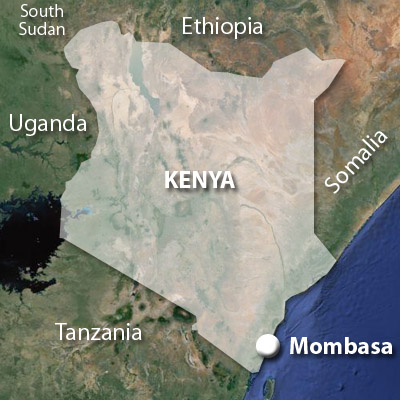 |
|
Regional revolts against Portuguese rule, inspired by Turkish leader Emir 'Ali Bey, booted the Portuguese from Mombasa in 1585. In 1587 a tribe of cannibals called the Zimba attacked Mombasa, ate everybody, and went home: Hardly anyone was left to defend Mombasa from the Portuguese, who sailed back into the city and reclaimed it in 1589.
|
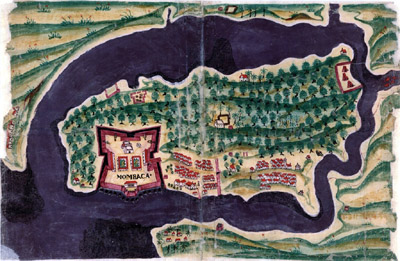 A 1635 drawing of Fort Jesus at Mombasa. Note how little it actually looks like Fort Jesus. Was someone trying to keep its rather unappealing man-like shape a secret from the higher-ups? Many improvements were made to the fort by its many inhabitants, however, so it is possible that today's Jesus differs substantially in appearance from yesteryear's Jesus. |
 |
Four years later, work was begun on Fort Jesus, in order to secure all things Portuguese on the east African coast. The fort was designed by Giovanni Battista Cairati (15?? - 1596), a Milanese military architect who was in charge of designing all of Portugal's fortifications in India and Africa. Cairati never visited Mombasa, but directed construction from afar.
About the same time that the Portuguese were first sacking Mombasa, they were doing much the same thing to Oman, a bit to the north on the Saudi peninsula. They built the non-starforty Fort Al-Mirani at the Omani port of Muscat in the early years of the 16th century. |
|
|
The rising Islamic tide of the Omani Sultanate ousted the Portuguese from Fort Al-Mirani in 1649, and sacked Mombasa in 1660...but they were unable to conquer Fort Jesus, which proved a formidable obstacle, even when garrisoned by relatively few determined defenders.
|
The Omanis returned in March of 1696, wearing their finest besieging hats (please note that there is not actually such a thing as a besieging hat). Fort Jesus was besieged for nearly three years, during which time the fort's garrison slowly died off due to sickness and/or starvation, was replaced by small numbers of Portuguese reinforcements who then dutifully sickened and died...a process that repeated itself at least three times. The Queen of Zanzibar sent supplies to the fort, and a large Portuguese relief force was finally sent in December of 1698, but it arrived just in time to be cheekily waved at by Omanis on Fort Jesus' ramparts, for the last of the surviving pro-Portuguese Arab defenders had finally been overcome.
The Sultanate of Oman held Mombasa and Fort Jesus until 1728, when the Portuguese came back fighting, reclaiming both city and fort once again.This lasted until 1746, when the Omanis bashed their way back into Fort Jesus, and held Mombasa until 1824. This time Great Britain was the colonial power overseeing a lengthy period of various different guises of rule, which lasted for the next 140 years. |
 |
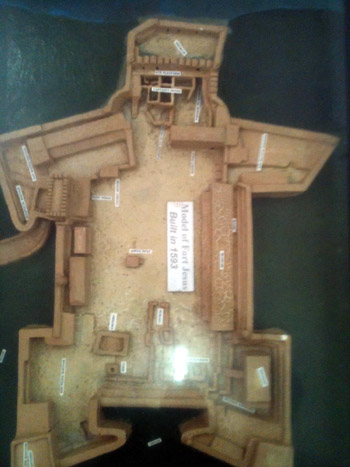 Hard to tell from the actual satellite image, but Fort Jesus was designed to resemble the shape of a man. Easier to see that in this model of the fort in its museum. See? It's a dude. |
|
|
It's difficult to surmise precisely why Great Britain felt such a strong need for Kenya, as it doesn't appear that Kenya had a whole lot to offer the British Empire. But Germany, late to the Colonialism game due to its relatively recent unification as a nation (1871), was busily colonizing anything that the rest of the European powers hadn't already claimed, which in the late 19th century included little more than parts of Africa. And checking German colonial power might have been all the reason Britain needed. Plus, if you're the British Empire, you colonize places. That's what you do.
|
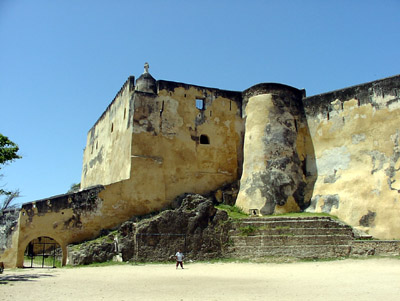 Fort Jesus: As formidable as it is yellow. Fort Jesus: As formidable as it is yellow. |
 |
From 1837 to 1895, Fort Jesus housed British troops. The city of Mombasa was "officially" given to the British in 1898 by the Sultan of Zanzibar, whereupon the "official" British Protectorate of Kenya was declared, with Mombasa as its capitol. The British made Fort Jesus a jail, replacing huts inside the fort with cells.
Britain built a railway through Kenya at the end of the 19th century, which didn't make the region's native tribes any happier than had been the American Indians when steam-spewing mechanical monsters started chuffing through their lands some decades earlier.
|
|
The Nandi was the first of several tribes in Africa to be moved to reservations, preventing them from disrupting the railroad's completion. Other troublemakers were doubtless imprisoned at Fort Jesus.
|
The British finished their railroad in 1890, which led to a financial boom in Mombasa: See, Africans? Your imperial masters really do know best!
Those imperial masters clung to Kenya until December 12, 1963, when independence was finally granted. Fort Jesus was declared a national park in 1958.
Fort Jesus today is open daily for visits. Inside are a museum related to the fort, plus a Swahili Cultural Center and a Malacology Unit. |
 |
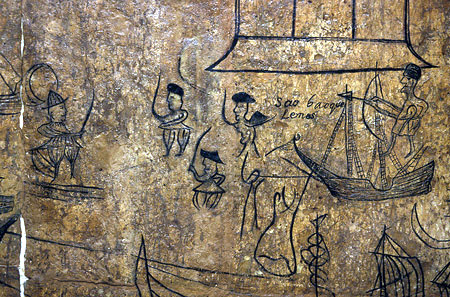
Lots of bored Portuguese sailors spent time at Fort Jesus, some of whom fancied themselves artists. |
|
|
The Malacology Unit is a branch of the Institute of Primate Research in Nairobi, Kenya. Agents of the Unit collect snails and test them for schistosomiasis, a parasitic disease that is second only to malaria in African socioeconomic (negative) impact. Exactly for what the starfort was initially designed: Snail research.
|
|
|
|
|
|
 |




